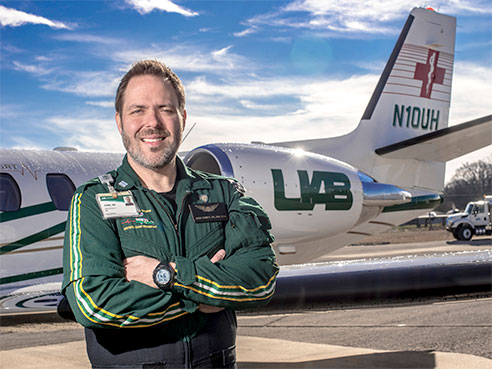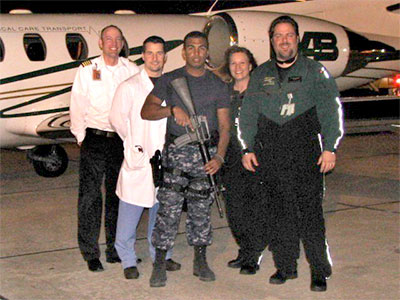 The plane rolled to a stop on the tarmac in the middle of the night, the warm, salt smell of the Caribbean wafting from the nearby beach. John Doriety opened the hatch of the Cessna Citation Bravo to see that the plane was surrounded by men in camouflage, carrying automatic weapons. They were — fortunately — United States Marines, part of the garrison at Gitmo, the U.S. military base at Guantanamo Bay, Cuba.
The plane rolled to a stop on the tarmac in the middle of the night, the warm, salt smell of the Caribbean wafting from the nearby beach. John Doriety opened the hatch of the Cessna Citation Bravo to see that the plane was surrounded by men in camouflage, carrying automatic weapons. They were — fortunately — United States Marines, part of the garrison at Gitmo, the U.S. military base at Guantanamo Bay, Cuba.
Doriety and the rest of the team from the Critical Care Transport Service at the University of Alabama at Birmingham were at Gitmo following the devastating earthquake that hit the nearby island of Haiti in January 2010. A U.S. military officer had been badly injured in the quake. First responders had brought him to the Gitmo base hospital by helicopter, and CCT had been summoned to get him stateside, to more advanced medical care.
It was another day at the office for Doriety, a registered nurse for CCT. He, along with medical director Kevin Barlotta, M.D., respiratory therapist Regena Bragwell, RT, and two pilots, had brought UAB’s Cessna air ambulance — its flying intensive care unit — to pick up the injured officer. It was one of the more than 2,000 medical transports Doriety has made during his 15 years with CCT. 643 transports by air, 1,357 by ground ambulance, the most of any CCT employee in the program’s history. The milestone 2,000th was a trip on January 28.
Doriety, an army brat, graduated high school in Birmingham and studied at UAB to be an emergency medical technician. A part time job driving ambulances gave him a taste of medical transport. He earned his nursing degree from the UAB School of Nursing in 1998 and worked several years in emergency and trauma nursing. But the idea of medical transport was always in the back of his mind.
“You never know where you are going to go, how long it will take or when you’ll be back,” Doriety said. “A lot of times, we’re the last glimmer of hope for patients, to safely get them to a hospital that can provide the kind of care they require, where ever they might be.”
In the early 1980s, UAB realized that patients with significant medical issues requiring transfer between hospitals needed a better transport system than an ordinary ambulance. They needed air and ground vehicles with the same kind of equipment found in a hospital intensive care unit, staffed by the same kind of medical professionals who work in those units.
That led to the creation of CCT, which has carried out more than 47,000 medical transports, covering 42 million miles, 46 states and 38 countries. Beside the aircraft, CCT has three specially equipped ground ambulances, capable of transporting the sickest patients requiring the most complex care.
Several trips stand out in Doriety’s memory. Last February, he was on UAB’s first flight to collect a patient on ECMO, extracorporeal membrane oxygenation. ECMO patients are very sick, and very fragile. UAB is one of the few transport operations in the nation that will even attempt to move an ECMO patient by air. It is a daunting undertaking, because at 36,000 feet, there is no help if something goes wrong.
 UAB CCT's historic first overflight of Cuba. Pilot Justin Koenig, Dr. Kevin Barlotta, a US Marine, Regena Bragwell, and John Doriety in front of their flying intensive care unit.
UAB CCT's historic first overflight of Cuba. Pilot Justin Koenig, Dr. Kevin Barlotta, a US Marine, Regena Bragwell, and John Doriety in front of their flying intensive care unit.
“The ECMO transport team included a physician and UAB perfusionists, along with the usual crew,” Doriety recalled. “There was a lot of preparation and planning, and a lot of communication and coordination with the team on the ground at the other hospital. Ultimately, it was a pretty smooth flight.”
CCT has now flown six ECMO patients to UAB, and Doriety has been on three of the flights. He estimates he has done about 50 flights with cardiac patients coming to UAB for open heart surgery or transplant who required a continuous balloon pump, another procedure that many medical transport companies will not touch. He took part in one high profile case when CCT transported a member of the family who had become ill in the U.S. Virgin Islands in March 2015 from suspected pesticide poisoning.
“The medevac company operating in the Virgin Islands was overwhelmed and needed additional resources,” said Laura Lee Demmons, director of UAB CCT. “Their medical director had been a member of the U.S. Air Force special operations medical team embedded at UAB, and knew of CCT’s capabilities. We were able to send John and our crew to provide assistance, testimony to UAB’s continually growing national and international reputation.”
Demmons, one of the few CCT employees who has been with the program longer than Doriety, says he is the right guy for this kind of job.
“John is exactly the kind of nurse that UAB and CCT need to represent us around the country and around the world,” she said. “He is an outstanding clinician, great ambassador, inspiring educator and a master diplomat. We have a lot of great employees in Critical Care Transport, and John’s leadership and example are a large part of what makes our team so successful.”
Back to that Gitmo trip. The airport is on the other side of the bay from the hospital, so they had to take a small boat across, which meant leaving their stretcher behind. The Navy loaded the base ambulance, with the patient and team inside, into a large landing craft, the kind they use for amphibious operations, for the return voyage to the airport. That is when the trip got really interesting.
Gitmo is on the southeast coast of Cuba, about as far from the United States as any point on the island. Incoming flights have to stay outside of Cuban airspace, and make a long detour around the island. But with an injured man aboard for the return flight, a direct, shorter and quicker route home was essential.
Approval to take the shorter route would mean UAB’s jet would become the first U.S. aircraft in five decades to make an official flight through Cuban airspace.
“We got permission to overfly Cuba, the first U.S. aircraft to do so since a new, fledging agreement regarding medevac flights was negotiated between Cuba and our government,” Doriety said. “We were a little nervous to be the test case for the new rules, hoping that nothing went wrong. It was comforting to finally land on U.S. soil. Those kinds of flights are routine over Cuba now, but we were the first since the revolution.”
Doriety has no plans to curtail his medical transports. He is planning on getting his master’s degree in nursing at some point, but he and his wife, also a critical care nurse, have four children to get through school first. The oldest is about to start medical school this year, no doubt inspired by dinner-table tales of saving lives on the ground and in the air.